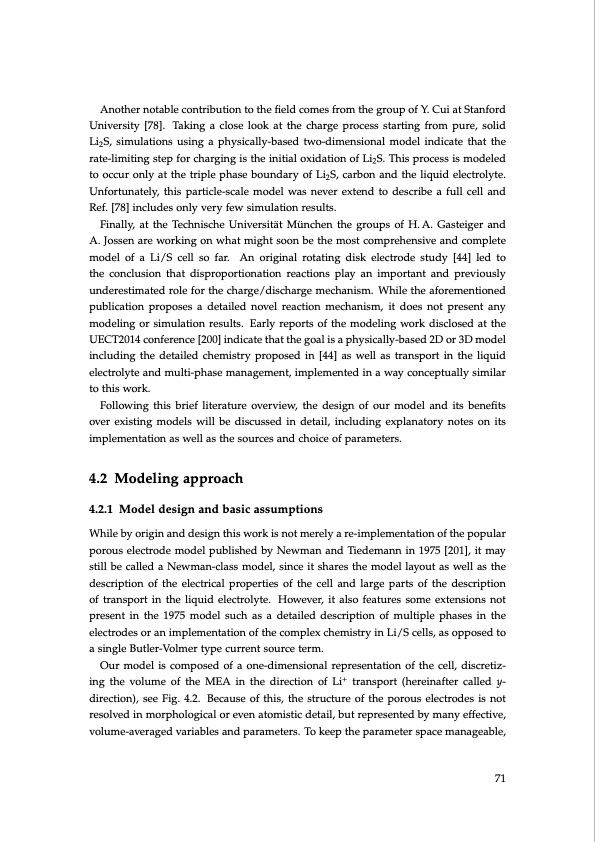
PDF Publication Title:
Text from PDF Page: 071
Another notable contribution to the field comes from the group of Y. Cui at Stanford University [78]. Taking a close look at the charge process starting from pure, solid Li2S, simulations using a physically-based two-dimensional model indicate that the rate-limiting step for charging is the initial oxidation of Li2S. This process is modeled to occur only at the triple phase boundary of Li2S, carbon and the liquid electrolyte. Unfortunately, this particle-scale model was never extend to describe a full cell and Ref. [78] includes only very few simulation results. Finally, at the Technische Universität München the groups of H. A. Gasteiger and A. Jossen are working on what might soon be the most comprehensive and complete model of a Li/S cell so far. An original rotating disk electrode study [44] led to the conclusion that disproportionation reactions play an important and previously underestimated role for the charge/discharge mechanism. While the aforementioned publication proposes a detailed novel reaction mechanism, it does not present any modeling or simulation results. Early reports of the modeling work disclosed at the UECT2014 conference [200] indicate that the goal is a physically-based 2D or 3D model including the detailed chemistry proposed in [44] as well as transport in the liquid electrolyte and multi-phase management, implemented in a way conceptually similar to this work. Following this brief literature overview, the design of our model and its benefits over existing models will be discussed in detail, including explanatory notes on its implementation as well as the sources and choice of parameters. 4.2 Modeling approach 4.2.1 Model design and basic assumptions While by origin and design this work is not merely a re-implementation of the popular porous electrode model published by Newman and Tiedemann in 1975 [201], it may still be called a Newman-class model, since it shares the model layout as well as the description of the electrical properties of the cell and large parts of the description of transport in the liquid electrolyte. However, it also features some extensions not present in the 1975 model such as a detailed description of multiple phases in the electrodes or an implementation of the complex chemistry in Li/S cells, as opposed to a single Butler-Volmer type current source term. Our model is composed of a one-dimensional representation of the cell, discretiz- ing the volume of the MEA in the direction of Li+ transport (hereinafter called y- direction), see Fig. 4.2. Because of this, the structure of the porous electrodes is not resolved in morphological or even atomistic detail, but represented by many effective, volume-averaged variables and parameters. To keep the parameter space manageable, 71PDF Image | Lithium-Sulfur Battery: Design, Characterization, and Physically-based Modeling

PDF Search Title:
Lithium-Sulfur Battery: Design, Characterization, and Physically-based ModelingOriginal File Name Searched:
Dissertation_David_N._Fronczek_The_Lithium_Sulfur_Battery.pdfDIY PDF Search: Google It | Yahoo | Bing
Sulfur Deposition on Carbon Nanofibers using Supercritical CO2 Sulfur Deposition on Carbon Nanofibers using Supercritical CO2. Gamma sulfur also known as mother of pearl sulfur and nacreous sulfur... More Info
CO2 Organic Rankine Cycle Experimenter Platform The supercritical CO2 phase change system is both a heat pump and organic rankine cycle which can be used for those purposes and as a supercritical extractor for advanced subcritical and supercritical extraction technology. Uses include producing nanoparticles, precious metal CO2 extraction, lithium battery recycling, and other applications... More Info
| CONTACT TEL: 608-238-6001 Email: greg@infinityturbine.com | RSS | AMP |